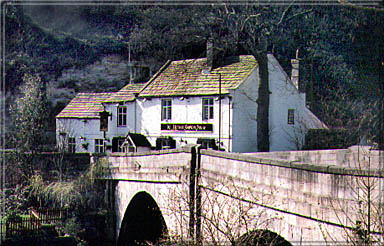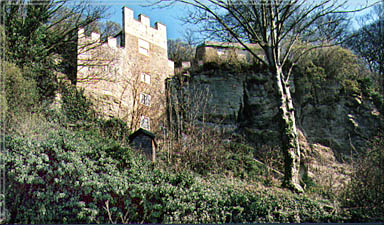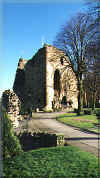
Knaresborough
As a family we have spent much time here, until a few years ago we had a static caravan down by the river - happy days. The town could well be the most picturesque in North Yorkshire. It occupies a spectacular position overlooking the River Nidd. It has plenty to offer - a castle, the oldest chemist shop in England, historic streets, boating and a mixture of delightful buildings - including a house built into a rock. A market has been held on a Wednesday since at least 1310. There are far too many pubs to mention. You can add to this some very unusual offspring, legends and folklore.

Mother Shipton Inn
The particular siting of the town may well be due to its easily defended location - the castle remains stand on a rocky outcrop 120 feet above the
river. Ancient Britons gave the Nidd its name over 2000 years ago.
Knaresborough was perhaps, originally a Knar - a stump situated on a burgh or fortified site. Knaresborough is situated in a deep gorge formed by the River. The gorge is overlooked by the ruins of
Knaresborough castle which was built in Norman times by a baron named Serlo de Burg. It was later rebuilt in the fourteenth century and the ruins date from
then. Many famous people are associated with Knaresborough Castle including King Richard II who was imprisoned here in 1399 prior to his imprisonment and murder at Pontefract castle in 1400. The castle's life came to an end during the Civil War when, as a Royalist stronghold it was destroyed by Parliamentarian
troops in
1646.

The House in the Rock
Mother Shipton was born at Knaresborough in a riverside cave during a violent thunderstorm
in 1488. She is England's most famous Prophetess. Her real name was Ursula Southeil, her mother, Agatha, died giving birth to
her. The birth was said to be accompanied by eerie screams. Throughout her childhood Ursula was associated with
mysterious and supernatural events. She married Toby Shipton, a local carpenter, near York in 1512 and she became well known as a fortune teller. Her crooked facial features frightened many,
her nose was said to 'glow in the dark.'
Her prophetic visions were known and feared throughout England. It is said
that she foretold the dissolution of the monasteries, the defeat of the Armada,
the Civil War and the Great Plague. Samuel Pepys' Diary grimly records that Mother Shipton gave forewarning of the Great Fire of London in 1666.
She told that Cardinal Wolsey would never be enthroned Archbishop of York.
Wolsey told her that when he did enter York he would burn her alive as a
witch. Later, Wolsey was to be arrested on a charge of high treason, he was
then taken ill and died - spooky. Today her prophecies are still proving uncannily accurate. Many have been fulfilled - perhaps you will understand
some of her words:
'Carriages without horses shall go.
And accidents fill the world with woe.
Around the world thoughts shall fly
In the twinkling of an eye...
Under water men shall walk,
Shall ride, shall sleep, shall talk;
In the air men shall be seen
In white, in black, and in green.
Iron in the water shall float
As easy as a wooden boat.'
She even forecast her own death in 1561, not only the day but also the hour. Although she was regarded as a witch, a title given to many who wavered from the church's theology, she was a respected one and had many friends who wept bitter tears when she solemnly bade them farewell to fulfil her own last prophecy.
Even if you don't believe in witches or Mother Shipton's prophecies, you cannot deny the magic power of the petrifying well near Mother Shipton's cave which
turn things to stone. Objects are hung up inside the cave and the waters from the petrifying well gradually turn the objects to stone with their limestone sediment....good
for children of all ages.
The Castle Keep (Click image to enlarge)
'Blind Jack Metcalf,' a very remarkable
Yorkshireman, was born here in 1717. He caught smallpox as a
boy, this made him blind. Blind or not - he excelled at all he did. He was a violinist,
major road builder, forest guide, an expert swimmer and smuggler. He died on the 26th of April 1810 at
the age of 93.
A pub in the Market Place bears his name.
Hugh de Morville was Constable of the Castle of Knaresborough and leader of the unfortunate group of four knights who took King Henry II at his word when he said
'Will nobody rid me of this turbulent priest.' On December 29th, 1170 they murdered Thomas
à Beckett, Archbishop of Canterbury, on the steps of the altar of his cathedral. The four knights first fled to Knaresborough, where legend has it that they were reviled even by the dogs of the town, although Hugh is also said to have built Hampsthwaite Church and dedicated it to the canonised priest
as an act of penance.
Apart from Mother Shipton, Blind Jack and the murderers of Thomas à Becket, a number of other famous folk are associated with
Knaresborough. Guy Fawkes once lived here, Edward III visited here and Oliver Cromwell slept in a
fishing lodge here. Other Knaresborough notables include William Slingsby
the founder of Harrogate's spa who is commemorated in Knaresborough's church.

St Robert's chapel, carved into a rock face alongside the River Nidd in 1408 commemorates Robert Flower a hermit who lived at in a cave here. He reputedly had a gift for healing. In a later century a shoemaker was murdered by a schoolmaster in St Robert's Cave, adding yet more to the superstition
that surrounds this area. A strange larger than life carving on the cave
of a knight drawing a sword is said to be a representation of Robert.
So there you have it, visit in June you will also witness the famous Bed Race!
